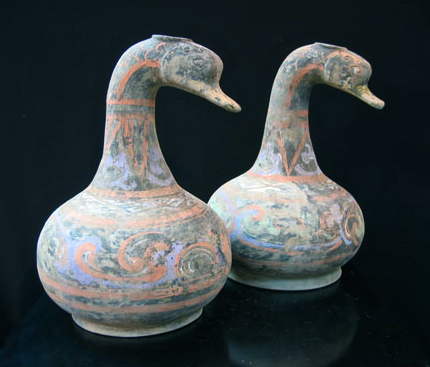

Title: Terracotta Polychrome Funerary Containers Chinese Han Duck Vessels
Shipping: $29.00
Artist: N/A
Period: Antiquity
History: N/A
Origin: N/A
Condition: Museum Quality
Item Date: 206 BC to 220 AD
Item ID: 6380
Pair of Terracotta Polychrome Funerary Containers Chinese Han Duck Vessels. Pair of Han Duck Vessels. Origin: China. Circa: 206 BC to 220 AD. Dimensions: 13" (33.0cm) high x 9" (22.9cm) wide Collection: Chinese Art. Style: Polychrome. Medium: Terracotta. These highly unusual vessels are funerary containers, that were interred with a deceased person of considerable social standing in order to aid their passage into the hereafter. The Han period is known for extensive sociopolitical change followed by stability, leading to the foundations of what is now recognised to be "Chinese Culture". The Han era also saw one of the greatest artistic outpourings in Chinese history, easily on a par with the glories of their Western contemporaries, Greece and Rome. Wealth pouring into China from trade along the Silk Road initiated a period of unprecedented luxury. Stunning bronze vessels were created, decorated with elegant inlaid gold and silver motifs. Jade carvings reached a new level of technical brilliance. But perhaps the artistic revival of the Han Dynasty is nowhere more apparent than in their sculptures and vessels that were interred with deceased nobles. Called "mingqi", literally meaning “spirit articles,” these works depicted a vast array of subject, from warriors and horses to ovens and livestock, which were buried alongside the dead for use in the next world, reflecting the Chinese belief that the afterlife was an extension of our earthly existence. These vessels are sinuously and elegantly designed, incorporating the neck and head of ducks into the spouts and handles, running into globular, rounded vessel bodies. While their function is equivocal, their form suggests that they might have been used as serving vessels for liquids, although it is more probable that they were made specifically for burial with the deceased. This would also explain their extremely good colour preservation. The floral and geometric designs are painted directly onto the body and neck/spout, and are arranged in bands that highlight the vessel's shape. The ducks' anatomical feaures are highlighted with contrasting dark and light paint - providing feathers and facial features - in addition to some further incised decoration around the head area. A highly unusual and desirable pair of vessels, which would be a credit to any collection.
Link: http://en.wikipedia.org/wiki/Funerary_art
Funerary art is any work of art forming, or placed in, a repository for the remains of the dead. The term also encompasses cenotaphs ("empty tombs"), tomb-like monuments which do not contain human remains; and communal memorials to the dead (such as war memorials), which may or may not contain human remains.
Funerary art may serve many cultural functions. It can play a role in burial rites, serve as an article for use by the dead in the afterlife, and celebrate the life and accomplishments of the dead, whether as part of kinship-centred practices of ancestor veneration or as a publicly directed dynastic display. It can also function as a reminder of the mortality of humankind, as an expression of cultural values and roles, and help to propitiate the spirits of the dead, maintaining their benevolence and preventing their unwelcome intrusion into the affairs of the living.
The deposit of objects with an apparent aesthetic intention may go back to the Neanderthals over 50,000 years ago, and is found in almost all subsequent cultures—Hindu culture, which has little, is a notable exception. Many of the best-known artistic creations of past cultures—from the Egyptian pyramids and the Tutankhamun treasure to the Terracotta Army surrounding the tomb of the Qin Emperor, the Mausoleum of Halicarnassus, the Sutton Hoo ship burial and the Taj Mahal—are tombs or objects found in and around them. In most instances, specialized funeral art was produced for the powerful and wealthy, although the burials of ordinary people might include simple monuments and grave goods, usually from their possessions.
An important factor in the development of traditions of funerary art is the division between what was intended to be visible to visitors or the public after completion of the funeral ceremonies. The Tutankhamun treasure, for example, though exceptionally lavish, was never intended to be seen again after it was deposited, while the exterior of the pyramids was a permanent and highly effective demonstration of the power of their creators. A similar division can be seen in grand East Asian tombs. In other cultures, nearly all the art connected with the burial, except for limited grave goods, was intended for later viewing by the public or at least those admitted by the custodians. In these cultures, traditions such as the sculpted sarcophagus and tomb monument of the Greek and Roman empires, and later the Christian world, have flourished. The mausoleum intended for visiting was the grandest type of tomb in the classical world, and later common in Islamic culture.